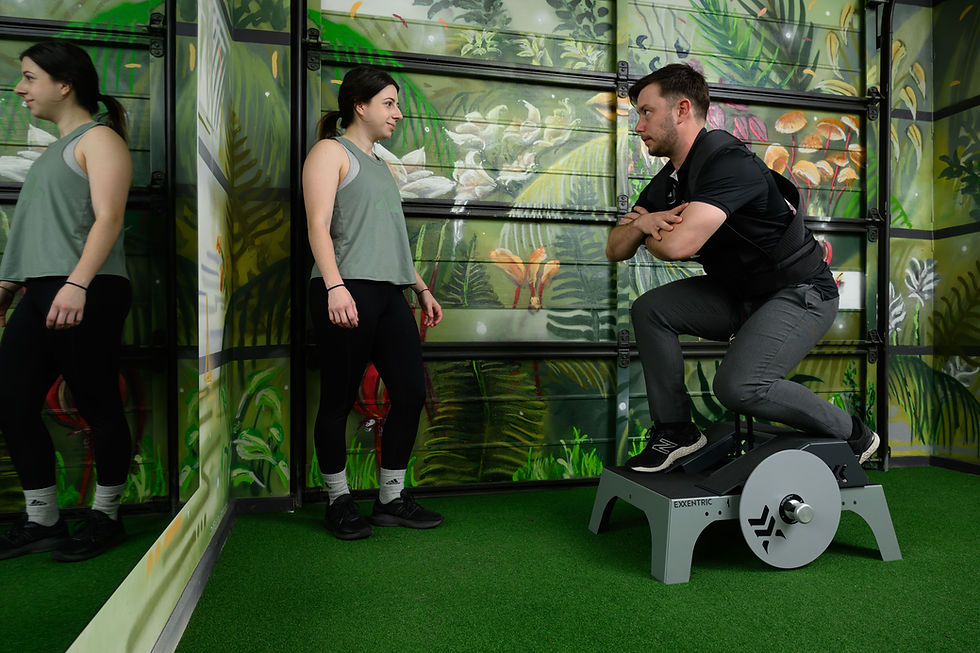The Power of Nordic Hamstring Curls: Benefits and Applications
- Thomas Pope

- Jul 25, 2024
- 3 min read

In the realm of physiotherapy and sports rehabilitation, Nordic hamstring curls have emerged as a popular exercise for preventing and rehabilitating hamstring injuries. Whether you're an athlete striving for peak performance or an individual recovering from injury, understanding the benefits and applications of Nordic hamstring curls can significantly enhance your rehabilitation and training regimen.
Understanding Nordic Hamstring Curls
Nordic hamstring curls, also known as Nordic curls or Nordic drops, are a bodyweight exercise primarily targeting the hamstring muscles. The exercise involves kneeling on a pad with ankles secured, and then slowly lowering the torso towards the ground while maintaining tension in the hamstrings. The eccentric (lengthening) phase of the exercise is particularly emphasised, as the athlete controls the descent with the hamstrings before using their hands to push back up to the starting position.
The Evidence-based Benefits of Nordics
1. Injury Prevention and Rehabilitation
Hamstring strains are prevalent in sports requiring explosive movements like sprinting and jumping. Research has shown that strengthening the hamstrings through exercises like Nordic curls can reduce the risk of initial injury and recurrence. According to a systematic review published in the British Journal of Sports Medicine, incorporating Nordic hamstring exercises into training programs can lower the incidence of hamstring strains by up to 51% among athletes ([Bahr & Holme, 2014](https://bjsm.bmj.com/content/48/7/579)).
2. Improvement in Muscle Strength and Function
Nordic hamstring curls are effective in improving eccentric hamstring strength, which is crucial for decelerating the leg during high-speed movements. This improvement in eccentric strength not only enhances athletic performance but also aids in better movement control and stability around the knee and hip joints.
3. Application in Elite Sport
The Australian Football League (AFL) provides a pertinent context for understanding the practical application of Nordic hamstring curls. AFL involves rapid changes in direction, high-speed running, and frequent jumping, all of which place substantial demands on the hamstring muscles. Research specific to AFL has highlighted the benefits of Nordic hamstring curls in reducing injury rates. For instance, a study conducted by [Sherry & Best, 2004](https://bjsm.bmj.com/content/38/4/363) found that a targeted prevention program including Nordic curls significantly decreased the incidence of hamstring injuries among AFL players.
Incorporating Nordic Hamstring Curls into Practice
Preventative Programs: Physiotherapists can integrate Nordic hamstring curls into injury prevention programs for athletes, emphasising proper technique and progressive overload to build hamstring resilience.
Rehabilitation Protocols: For individuals recovering from hamstring injuries, Nordic curls can be included in rehabilitation protocols to enhance strength and promote safe return to sport.
Performance Enhancement: Even for athletes without a history of hamstring issues, incorporating Nordic curls into regular training routines can fortify hamstring strength, thereby enhancing overall athletic performance and reducing the risk of future injuries.
Conclusion
Nordic hamstring curls stand out as a valuable tool in the arsenal of physiotherapists and sports professionals alike. Supported by contemporary evidence and embraced in high-performance sports such as the AFL, these exercises offer tangible benefits in injury prevention, rehabilitation, and athletic enhancement. Whether you're aiming to stay injury-free or striving for peak performance, Nordic hamstring curls are worth integrating into your training regimen under the guidance of a qualified physiotherapist. Embrace the power of these curls to unlock stronger, more resilient hamstrings and optimize your journey towards better physical health and performance.
References:
- Bahr, R., & Holme, I. (2014). Effect of Preseason Strength Training on Hamstring Injuries in Elite Soccer Players: A Randomized Controlled Trial. *The American Journal of Sports Medicine, 42*(7), 1479-1487.
- Sherry, M. A., & Best, T. M. (2004). A Comparison of 2 Rehabilitation Programs in the Treatment of Acute Hamstring Strains. *Journal of Orthopaedic & Sports Physical Therapy, 34*(3), 116-125.





Comments